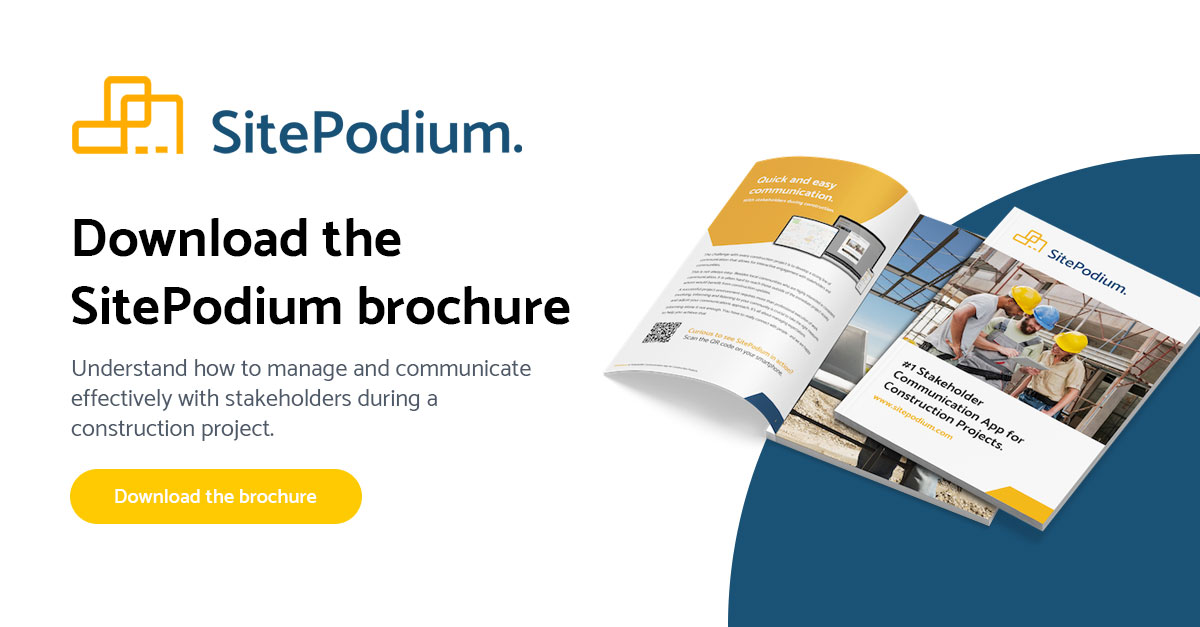In a previous blog we discussed what social value in construction is and why it matters. Here we will take a more practical approach and discuss the ways companies can add social value to the communities they work in. We will look at some real-life examples and at how progress can be effectively measured along the way.
At SitePodium we realise that one size never fits all. That is why we are not aiming to provide definitive answers. By stimulating dialogue and sharing good practice, we hope to create a more balanced and inclusive industry that better reflects and benefits all stakeholders involved. On top of that, we provide you with statistics and reports that show you how your efforts actually convert to the increase of social value around your construction project.
Social value in construction projects is what we are here for. So, let us have a look at how you can put this into practice.
What is Social Value?
The creation of social value is the conscious effort by a business or organisation to deliver outcomes that benefit the communities and societies around the project. The means by which they do this can be social, economic or financial. Social value is not tangible, like financial value is. It is a collective term for everything that matters to communities, like the creation of jobs, supporting community health and wellbeing, the improvement of the local environment, or strengthening community cohesion.
The importance of social value in construction projects has increased massively during the last few years. Improving the community around a building site is no longer just a public relations or reputational exercise.
Why has this become so important? Social value nowadays commonly appears as a standalone set of criteria on bids and tenders, demonstrating its serious impact on the bottom line. It supports the growing awareness both inside and outside the industry that people and communities are fundamental to the success of businesses.
By understanding what social value in construction is, you immediately see that it is not something that can be easily measured, like financial value can. Apps like SitePodium are a major improvement, and assist with measuring social value during your construction project.

Ways to kick off your social value strategy
If you want to incorporate social value into your construction project properly, you need a place to start.
- A social value impact framework
The first thing you can do, is setting up a social value impact framework. Here it is important to remember that what works in one location of community, might not in another. Therefore, do your homework, listen to different local stakeholders, and ensure that frameworks are locally relevant before laying down any targets or metrics.The social value impact framework will be different for every construction project you work on. - Start internally
Another way to kickstart your social value strategy is by looking internally first. Take the time to discover what is important to your staff and what they would like to see, before matching this to the needs and wants of local communities.Doing this has several advantages:- Your staff is at the frontline of your business and has a better idea of what matters most to the local people.
- You boost internal morale by consulting them first.
- You will enhance buy-in ownership of any social value initiatives you end up implementing.
- You show your staff that you are a responsible employer who is proud of the way he/she operates.
- External efforts
Obviously, the external community around your construction project is the one you need to convince. And there you kickstart your social value strategy by conducting community engagement surveys, offering focus groups, and running in-person or online consultations to discover what really matters to local people.Once a community’s wants and needs are understood, relevant projects can be developed around subjects such as health and wellbeing, environmental impact, employment, training and skills, etcetera.Community engagement apps like SitePodium encourage effective two-way communication with members of the local community, allowing multi-media information such as text, photos and videos to be quickly and easily shared in real time. - Supply chain
The supply chain is another place where companies can enhance social value. Ask suppliers to demonstrate how they align with your social and environmental policies. There may well be synergies that can be established and drawn out.
Measuring social impact
Without clear guidelines and definitions, and little in the way of accountability through globally-agreed targets and reporting requirements, it is easy to think ‘Why should I bother with Social Value? It is time-consuming, difficult to measure, and no one will check on it anyway…”
There are two ways to measure social impact, namely with quantitative and qualitative data. We recommend to use both, for a complete picture of the social impact on your communities.
Using quantitative data
Measuring social impact does not have to be complex and painful. Just a small amount of quantitative data can make the world of difference. Start by gathering some baseline statistics to create a picture of the community and to understand if what you are doing is impacting them the way you intend it to.
Here, the aim is not to collect information for the sake of it. Identify specific themes and targets that will create a genuine impact. Develop scores to rate your social impact goals. If these do not improve over time, look at what is not working and adjust your strategy accordingly. By going through these steps repeatedly, you will eventually end up with a social value framework that is measurable and that hits the targets.
Here are some examples of baseline metrics for social value in construction:
- The number of local residents under employment.
- The percentage of local residents paid the minimum living wage of the area.
- The number of external stakeholders engaged.
- The number of kilowatts or units of energy spent in a project.
- The amount of reduction in air pollution.
- The increase in biodiversity.
Use qualitative data as well
Qualitative data can also be used for measuring social impact. Investment in community schemes will generate powerful social impact stories over time. There will be people-centred narratives to supplement your data. The advantage of using both qualitative and quantitative data is that this mix will really bring your results to life. This is often welcomed by planners, local authorities in particular.
Get inspiration from other projects
Which companies are leading the way in incorporating social value in construction projects successfully? Here are two inspirational examples from current projects running in London where social value is at the top of their construction agenda.
Elephant Park
Elephant Park is a new residential development in London’s Elephant & Castle area, which aims to create one of the capital’s most exciting places to live, work and visit. Delivered by Lendlease in partnership with Southwark Council, the district aspires to be climate positive and centres around a large communal park with over 11 acres of additional green spaces such as pocket parks, gardens and green roofs.
New homes are energy efficient, using 30% less water than the average London home. In addition to creating 6,000 new jobs, planting 1,200 new trees and establishing over 3,000 new cycle spaces, the scheme aims to add social value through opportunities for employment, education, and training, providing new community spaces and a local community fund.
Dolphin Square
Dolphin Square is a large residential estate in London’s Westminster, owned and managed by AXA IM Alts. The year 2020 marked the beginning of a major restoration programme to preserve and modernise this classic estate, which was built over 80 years ago and is currently home to approximately 1,500 residents.
As Dolphin Square’s 13 houses are restored over the next 7 years, an extensive programme has been developed to consult, engage, and add social value to residents and the local community. Activity to date includes:
- A dedicated restoration programme website.
- SitePodium, a bespoke community engagement app.
- An in-person community engagement suite offering staff, residents and local stakeholders the opportunity to attend in-person consultations and events.
- Free leisure classes including yoga, tai chi and a running club to enhance social interaction and cohesion around the estate.
Some helpful resources
Currently, there are no existing frameworks or overarching scoring metrics to define social impact. Firms must decide for themselves what social value means to their construction project and to the communities around it.
Having said that, the following resources may be helpful:
- The Guide to SROI (Social Return on Investment): originally written in 2009 by the UK Cabinet Office and updated in 2012, The Guide to SROI provides a clear framework for anyone interested in measuring, managing and accounting for social value or social impact. However, it is not specific to the construction environment.
- Annex A of the government’s 2020 Policy Procurement Note suggests five themes for the effective delivery of social value. These are COVID-19 recovery, tackling economic inequality, fighting climate change, equal opportunity, and wellbeing. The guidance includes delivery objectives and what good practise looks like within these five different areas.
Aligning with the UN Sustainable Development Goals – an internationally-agreed set of targets for a globally sustainable future – suggest another way to report and measure social impact. In particular, Goal 11 – ‘Make cities and human settlements inclusive, safe, resilient and sustainable’ – offers a wealth of targets and indicators to help you get started.
SitePodium improves and measures social value in your construction project
We have spoken about practical ways to first improve and secondly measure social value in construction. SitePodium helps you do both. If you have any comments or questions, or would like to learn more about how SitePodium supports your own approach to creating social value, send us a message.


